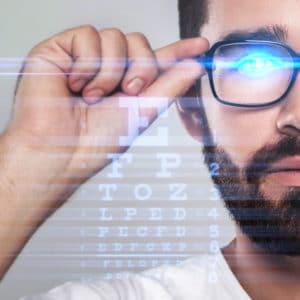
What are the Benefits of an Eye Exam?
Many people mistakenly believe that eye exams are performed to check their vision and update glasses or contact lens prescriptions. This is only one benefit of seeing the eye doctor as recommended. During a comprehensive eye exam, the eye doctor evaluates the condition of several ocular structures, from the lens of the eye to blood vessels to the retina at the back of the eye. The health of these structures is a good predictor of future eye health and the risk of potentially serious eye conditions.
In addition to confirming the health of the eyes, comprehensive exams also provide valuable information regarding a person’s general health. For example, medical conditions such as hypertension and diabetes often affect the blood vessels that support the retina.
Who is a Candidate for an Eye Exam?
Eye exams are recommended for infants as young as six months old and for children and adults of all ages. Routine eye exams are the only way to ensure a child is seeing clearly. Studies indicate that more children are diagnosed with myopia (nearsightedness) today than in previous generations. This presents greater risks for eye conditions like glaucoma and cataracts later in life. Eye exams can prevent the worsening of nearsightedness before a child starts school or anytime thereafter.
Teens and adults are also candidates for routine eye exams that evaluate vision, eye strain, dry eye, and the risks for eye disease.
How Often Should I get an Eye Exam?
Professional organizations advise routine eye exams for people of all ages. The timing of exams may go as follows:
At least one exam before the age of 3. This exam checks for common childhood eye problems like lazy eye.
Children should have another eye exam before starting 1st grade. After this time, exams may occur every 1 to 2 years.
Every 5 to 10 years from age 20 to 40.
Every 2 to 4 years from age 40 to 55.
Every 1 to 3 years from age 55 to 65.
After age 65, eye exams should occur every year or two.
If you have a family history of eye disease such as glaucoma or cataracts, have high blood pressure or diabetes, or have had an eye injury or surgery, your eye doctor will likely schedule eye exams more frequently.
Are Eye Exams covered by insurance?
Some insurance companies contain vision plans that extend specific coverage for eye exams, eyeglasses, and contact lenses. Medical insurance rarely covers eye exams except in the event of a medical eye problem. Patients should check with their insurance provider regarding the inclusion of a vision plan or other forms of coverage.
How much does an eye exam cost?
The cost of an eye exam can vary based on the various factors involved in care, including the tests that are conducted and whether or not the patient will be fitted for contact lenses. When exploring the costs of eye exams with different doctors or practices, it is important to confirm that the eye exam being offered includes the following (at least):
- Review of medical history and family health history.
- Eye chart testing that evaluates near and distance vision.
- Evaluation of nearsightedness, farsightedness, and astigmatism.
- Evaluation of how the eyes work together.
- Eye pressure testing to rule out glaucoma.
- Near vision testing to evaluate for presbyopia.
- Observation of the eyes’ interior structures to rule out retina problems and cataracts.
Are Eye Exams Painful?
Eye exams include several tests, none of which are painful. Some tests, such as the evaluation of pressure in the eye, include a burst of air into the eye. This test takes a few seconds and may feel odd, but not painful. In the event that the eye doctor needs to perform a test in which the ocular surface is touched, they can insert eye drops that numb the eye.
T schedule your annual eye exam, call our Sterling office at 540.722.6200.


